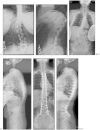Current status of adult spinal deformity
- PMID: 24436852
- PMCID: PMC3856386
- DOI: 10.1055/s-0032-1326950
Current status of adult spinal deformity
Abstract
Purpose To review the current literature for the nonoperative and operative treatment for adult spinal deformity. Recent Findings With more than 11 million baby boomers joining the population of over 60 years of age in the United States, the incidence of lumbar deformity is greatly increasing. Recent literature suggests that a lack of evidence exists to support the effectiveness of nonoperative treatment for adult scoliosis. In regards to operative treatment, current literature reports a varying range of improved clinical outcomes, curve correction, and complication rates. The extension of fusion to S1 compared with L5 and lower thoracic levels compared with L1 remains a highly controversial topic among literature. Summary Most adult deformity patients never seek nonoperative or operative treatment. Of the few that seek treatment, many can benefit from nonoperative treatment. However, in selected patients who have failed nonoperative treatment and who are candidates for surgical intervention, the literature reflects positive outcomes related to surgical intervention as compared with nonoperative treatment despite varying associated ranges in morbidity and mortality rates. If nonoperative therapy fails in addressing a patient's complaints, then an appropriate surgical procedure that relieves neural compression, corrects excessive sagittal or coronal imbalance, and results in a solidly fused, pain-free spine is warranted.
Keywords: coronal deformity; lumbar deformity; minimally invasive surgery; sagittal balance; surgical treatment.
Conflict of interest statement
Figures



References
-
- Birknes J K, White A P, Albert T J, Shaffrey C I, Harrop J S. Adult degenerative scoliosis: a review. Neurosurgery. 2008;63(3, Suppl):94–103. - PubMed
-
- Silva F E, Lenke L G. Adult degenerative scoliosis: evaluation and management. Neurosurg Focus. 2010;28:E1–E10. - PubMed
-
- Fu K M, Rhagavan P, Shaffrey C I, Chernavvsky D R, Smith J S. Prevalence, severity, and impact of foraminal and canal stenosis among adults with degenerative scoliosis. Neurosurgery. 2011;69:1181–1187. - PubMed
-
- Youssef J A, Hamlin L F. Rosemont, IL: American Academy of Orthopaedic Surgeons; 2009. Adult spinal deformity; pp. 721–726.
-
- Vanderpool D W, James J I, Wynne-Davies R. Scoliosis in the elderly. J Bone Joint Surg Am. 1969;51:446–455. - PubMed

